 
|
17th September
2005. approx 0:00UT (1:00AM BST) |
These are my first attempts at imaging Mars in 2005.
Mars is going to be much higher in the sky than last opposition
when it never really got much above 20 degrees.
I tried a couple
of techniques:
the first image (top) is a straight RGB capture
with a colour ToUcam (and a Baader UV-IR cut filter) this shows
some nice detail but it is slightly 'noisier' than my second image.
The
second image is in fact a combination of two images, one with the
webcam set to black and white through an IR pass filter and a second,
RGB as before. The IR image was used for luminance and the
RGB for colour only. This second combined image seems much clearer
and has some extra detail. However if you look closely some detail
missing on the IR-RGB image, is visible on the RGB only image.
Diameter: 16 Arc
Seconds |
Altitude: 30
degrees
Seeing: 7/10. Transparency: 8/10
Telescope: 222mm
F8 Newtonian. 3 x Barlow. EFL 5328mm (F24).
Drive: EQ-5.
Camera: Philips ToUcam 740 pro.
Settings: 1/33rd
sec, 10% gain, white balance auto. 10 frames per second. 90 second
AVI's
Capture Software: QFocus2
Processing Software: Registax
3. |
|
29th September 2005
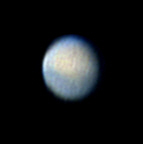  
|
Altitude: 25
degrees
Seeing: 3/10. Transparency: 7/10
Telescope: 222mm
F8 Newtonian. 2 x Barlow
Drive: EQ-5.
Camera: Philips Vesta
675.
Capture Software: QFocus2
Processing Software: Registax
3. |
|
1st October 2005
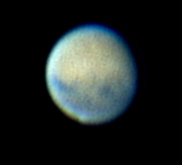 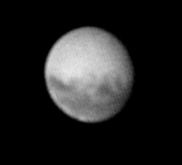 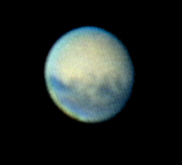
|
Altitude: 30
degrees
Seeing: 5/10. Transparency: 7/10
Telescope: 222mm
F8 Newtonian. 2 x Barlow
Drive: EQ-5.
Camera: Philips ToUcam 740 pro.(RGB)
Philips
Vesta 675 (SC3-B/W) - (IR)
Capture Software: QFocus2
Processing Software: Registax
3. |
|
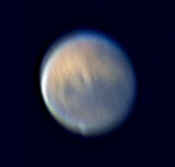 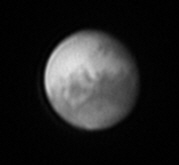 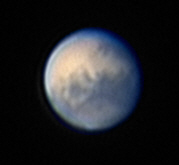
|
These images were taken
on the 5th/6th of October 2005.
The feature slightly to the lower left of centre
is known as the "Eye of Mars"
The top image was taken with a ToUcam 740 fitted
with a Baader UV-IR rejection filter. The atmospheric seeing wasn't
dire, though it was wabbling about quite a bit.
The middle image was taken using the same camera
but this time fitted with an IR pass filter (Made from exposed film).
The camera was set to black and white mode. The longer wavelength
and narrower bandwidth cut through the "average" seeing
contitions giving a better finished image.
The bottom image is a combination of the above two
images. The IR image was used for Luminance and the RGB only for
the colour component.
Diameter: 18.4 Arc Seconds
|
Altitude: 30
degrees
Seeing: 6/10. Transparency: 6/10
Telescope: 222mm
F8 Newtonian. 3 x Barlow. EFL 5328mm (F24).
Drive: EQ-5.
Camera: Philips ToUcam 740 pro.
Settings: (RGB)
1/33rd
sec, 45% gain, white balance auto. 10 frames per second. 90 sec
AVI's
Settings: (IR) 1/25th
sec, 67% gain, white balance auto. 10 frames per second. 90 second
AVI's
Capture Software: QFocus2
Processing Software: Registax
3. |
|
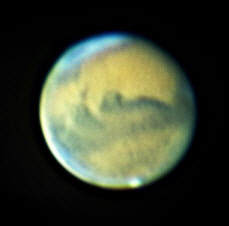 
|
BEST MARS TO DATE!!!
The seeing on the 15th of October
was the best I have ever had for Mars. Mars was high in the sky
by the time I took these images.
The first is an RGB from the ToUcam using a Baader UV-IR block
filter. I 2x resampled in Registax and then reduced the result by
75%. The detail is the best I have ever achieved.
The second image is the same as above but this time the ToUcam
was set to black and white and a IR pass filter replaced the
IR-UV block filter. Not how the North polar hood has all but disappeared
in IR light.
|
|
|
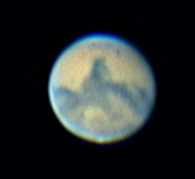 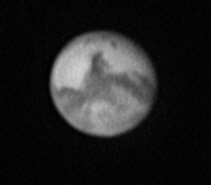 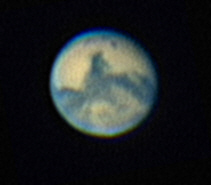
|
Two sets of images from before and after midnight on the 18th-19th
of October.
They are all produced using a 222mm F8 Newtonian., 2x Barlow
Extended and a ToUcam.
The right image is in RGB (with UV-IR block)
The middle image
is in IR
The left most image is the IR with RGB combined.
|
|
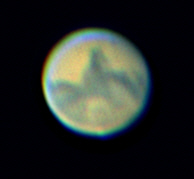 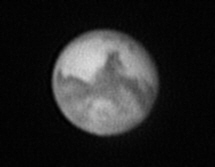 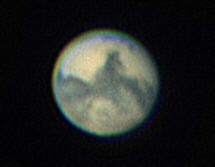
|
|
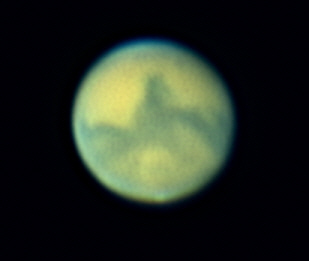 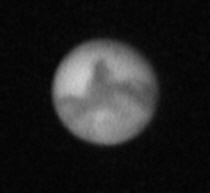
|
The two images opposte are from the 18th-19th October again.
The larger image is 2x resampled in Registax, then reduced to
80%. The smaller image is an atempt to image in UV light only.
|
|
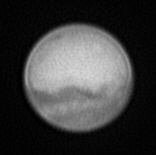 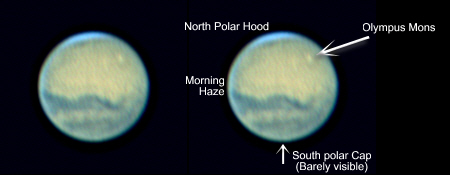
|
2nd Nov 2005
I had an hour and a half of intermittant clear skies. Dodging
clouds and fighting gusts of wind which shook the telescope. But
finally I have imaged a Martian volcano! The far image is in IR.
|
|

|
|
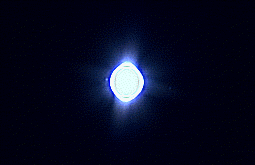 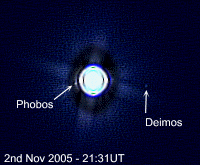
|
Martian Moons.
Theses images are of the moons of Mars. Phobos the closest and
brightest. Deimos further out and fainter.
Mars is a very over
exposed white blob.
|
|
The Moons were captured using an unmodified ToUcam fitted with
a Mogg 0.6 focal reducer through my 222mm F8 Newtonian.
The image
at 21:31UT is a combination of two images one at lower gain to image
Phobos (but Deimos didn't show) and another higher gain image to
capture Phobos. Thus the slightly odd looking over exposed Mars.
The setting were 300 frames at 5fps, 1/25th shutter at 65% and 95%
respectively.
The image taken at 23:51UT captured both moons
in one exposure. The settings were 300 frames at 10fps, gain 90%.
Phobos was further away from Mars at this time and wasn't caught
in the glare of the over exposed planet. The animation on the left
is the 23:51 image followed by a composite of the moons and a correctly
exposed Mars.
|
|
6th November 2005
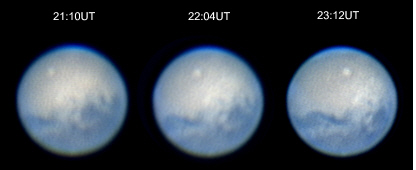 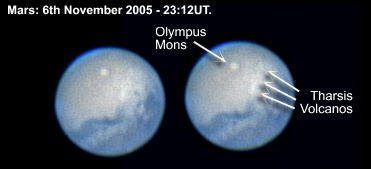
|
|
13th November 2005.
A very steady clear night.
I managed to get some decent images of Mars. I am wondering whether
I have imaged a localized dust storm on one of my images. I you
roll your mouse over the image (right) to see the region arrowed.
I looks to me like a comet shaped plume of dust, the plume pointing
to the eleven 'o'clock position - but I am no expert.
Below are a sequence of images from the same night.
Unfortunately the final image was slightly over exposed. This
has left the image lacking some detail in the brighter areas. I
think I was too tired by this stage and plagued by a few clouds.
|
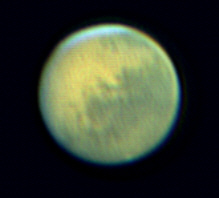
|
|

|
|
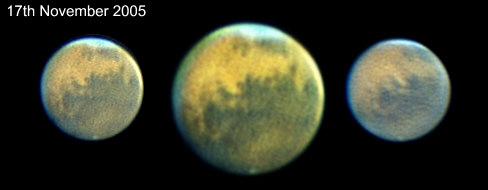
|
17th November 2005
|
|
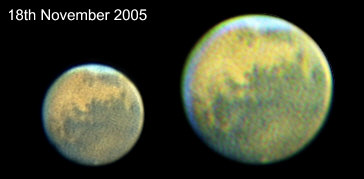
|
18th November 2005
|
|

Roll
over the image with your
mouse to see the moons labeled.
|

|
19th November 2005
This night had the best seeing I have witnessed for
a long long time. Mars was very clear in the eyepiece and pretty
steady from frame to frame of the AVI.
The far image is of the
moons of Mars which were well separated from the planet at this
time
|
|
22nd November 2005
|
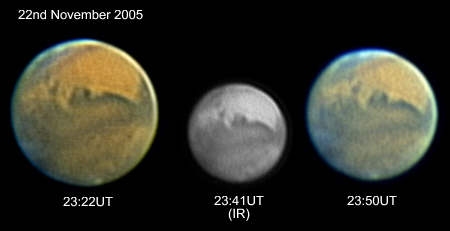
|
The seeing this night wasn't as good as the 19th
but it did still produce some reasonable images. Note the slight
difference in the dark markings in Infra-Red light as opposed to
visible light. Also the clouds are not visible in IR.
|
|
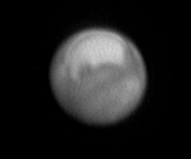
|
24th November 2005
Breezy night with poor seeing. I took two images,
one in RGB colour and one IR filtered. The IR filtered image shows
a bright arc through the north of the planet. I have a suspicion that
this might be a processing / stacking artifact and not real.
However it does appear to correspond with the edge of the north
polar hood of cloud, especially on the left hand side.
Roll your
mouse over the image at the left and compare the RGB and IR
images for yourself.
|

|
|

|
29th November 2005
The seeing on this night initially looked good
in the eyepiece. Once the webcam was attached it was soon obvious
that the seeing wasn't perfect. The best images were obtained around
9:30 to 10:00pm.
|
|
These images (Right) are the same as the ones above
but enlarged by 133%. No extra detail visible but slightly easier
to see.
|
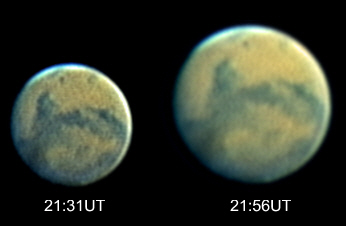
|
|
6th December 2005
This is my first clear image of Elysium Mons,
one of the huge volcanos of Mars (the brighter circular feature
arrowed). There is also evidence of evening
and morning mist in the South of the planet, now in the height of
the southern hemisphere summer.
|

|
The Seeing was reasonable for a short period on
this night.
It's very noticable how the planet is now starting
to shrink. In this image it is now only 15.9 arc seconds in size after
being over 20 arc seconds at the beginning of November. Also notice that
the planet is showing a distinct slight phase again.
|
|
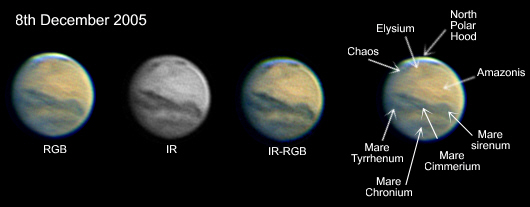
|
8th December 2005 - 23:00UT
Mars is now receeding rapidly from the earth.
15.6 arc seconds in size. Again a reasonably steady night - I managed
20 minutes of imaging. The results are a one-shot RGB image throught
the ToUcam (with IR-UV blocking filter) and an IR-Pass filtered
image again through the ToUcam. Both connected to the 222mm F8 Telescope.
|



